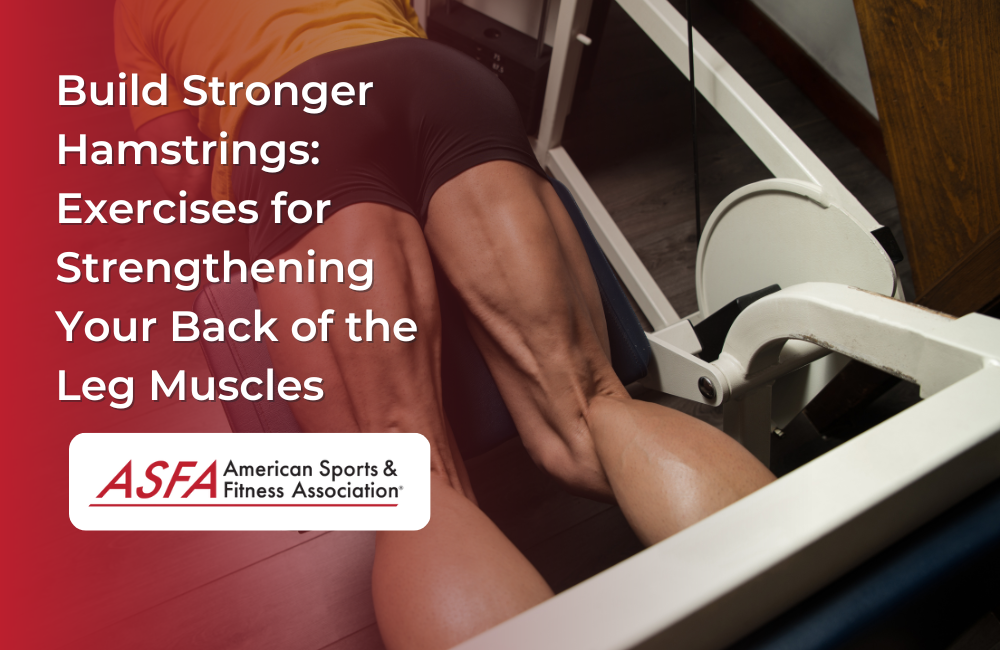The Critical Role of Hamstrings in Leg Strength, Stability, and Athletic Performance
Hamstrings play an indispensable role in leg strength, stability, and overall athletic performance. These muscles, situated at the back of your thigh, are fundamental to a range of daily movements such as walking, running, and jumping. Despite their importance, hamstrings are frequently overshadowed by the quadriceps, the more prominent muscles located at the front of the thigh. This oversight can lead to muscle imbalances, diminished performance, and an increased likelihood of injury. In this blog post, we’ll delve into the significance of hamstring strength and share a comprehensive set of exercises endorsed by the American Sports and Fitness Association (ASFA) to help you build stronger, more resilient hamstrings. We will also cover the best hamstring exercises in detail to ensure you achieve optimal muscle activation and lower-body performance.
Why Strong Hamstrings Are Essential
Strong hamstrings and leg muscles are not just about avoiding injury—they are pivotal to overall leg health and athletic prowess:
-
Balance and Stability: The hamstrings work in concert with the quadriceps to ensure balance and stability during movement. By fortifying your hamstrings, you can prevent the muscle imbalances that often lead to injuries, particularly in the knees and hips.
-
Enhanced Athletic Performance: Hamstrings are crucial for explosive power, enabling dynamic actions like sprinting, leaping, and rapidly changing direction. Strong hamstrings are also essential for deceleration, which is just as important as acceleration in sports performance.
-
Injury Prevention: Weak hamstrings are significantly more susceptible to strains, pulls, and tears—especially during high-intensity activities like sprinting, soccer, or basketball. By strengthening these muscles, you not only reduce the risk of injury but also improve overall leg function, making movements more efficient and less taxing on your body.
Understanding the Anatomy and Function of the Hamstring Muscles
The hamstrings are composed of three primary muscles: the biceps femoris, the semitendinosus, and the semimembranosus. These muscles originate from the ischial tuberosity of the pelvis and extend to insert below the knee joint. Collectively, they are responsible for knee flexion and hip extension, playing a critical role in movements that involve pushing off the ground, such as running and jumping. Effective hamstring workouts require movements that involve bending at the knee joint, such as leg curls and Romanian deadlifts. The hamstrings also contribute to the stabilization of the knee and pelvis, ensuring smooth, coordinated movements during physical activities.
Benefits of Building Strong Hamstrings
Building strong hamstrings offers a multitude of benefits that extend beyond the gym and into everyday life. Here are some key advantages:
-
Improved Athletic Performance: Strong hamstrings are essential for athletes, as they enhance power and speed. Whether you’re sprinting, jumping, or making quick directional changes, robust hamstrings can significantly boost your performance.
-
Injury Prevention: One of the primary benefits of strong hamstrings is their role in injury prevention. They provide crucial stability and support to the knee joint, reducing the risk of strains and tears. This is particularly important for athletes who engage in high-intensity sports.
-
Better Posture: Weak hamstrings can lead to poor posture, as the body compensates by leaning forward. Strengthening these muscles helps maintain proper alignment, reducing the risk of back pain and improving overall posture.
-
Enhanced Everyday Activities: From walking and running to climbing stairs, strong hamstrings make daily activities easier and more efficient. They contribute to better leg function, allowing you to move with greater ease and less fatigue.
Effective Exercises for Strengthening Your Hamstrings: Best Hamstring Exercises
To build stronger hamstrings, it’s essential to include a diverse range of exercises that work these muscles through their entire range of motion. The following exercises are recommended by the ASFA for their effectiveness in targeting the hamstrings:
-
Romanian Deadlifts (RDLs): This exercise is a cornerstone for hamstring development. Begin by standing with your feet shoulder width apart, holding a barbell or dumbbells in front of your thighs. Keeping your back straight, your arms straight, and your knees slightly bent, hinge at the hips to lower the weights toward the ground. Ensure you feel a stretch in your hamstrings before using them, along with your glutes, to pull yourself back to the starting position. Aim for 3-4 sets of 8-12 repetitions.
-
Glute-Ham Raises: This advanced exercise targets the hamstrings’ ability to control movement under load. Secure your feet on a glute-ham developer (GHD) or similar equipment, with your knees resting on the pad. Slowly lower your torso forward until it’s parallel with the ground, then engage your hamstrings and push your hips forward to raise yourself back up. Perform 3-4 sets of 8-12 reps, focusing on maintaining control throughout the movement.
-
Ball Hamstring Curls: This exercise emphasizes the eccentric phase of hamstring contraction. Start by lying on your back with your feet positioned on a ball and your hips lifted off the ground. Using your heels, dig into the ball and curl it towards your glutes, then slowly extend your legs back to the starting position. This exercise is particularly effective for developing hamstring endurance. Complete 3-4 sets of 10-15 repetitions.
-
Seated or Lying Leg Curls: Utilizing a leg curl machine allows for isolated hamstring work. Whether seated or lying down, focus on the contraction of your hamstrings as you curl your legs towards your glutes. This isolation movement helps build hamstring strength without involving other muscle groups. Perform 3-4 sets of 8-12 reps, ensuring you maintain proper form throughout.
-
Single-Leg Deadlifts: This unilateral exercise challenges balance and coordination while targeting the hamstrings. Stand with your feet shoulder width apart on one leg, holding a dumbbell or kettlebell in the opposite hand. Hinge at the hips and lower the weight toward the ground, keeping your back straight and the supporting leg slightly bent. Return to the starting position and repeat on the opposite leg. Perform 3-4 sets of 8-12 reps per leg, focusing on controlled, deliberate movements.
Best Practices for Safe and Effective Hamstring Training
To maximize the effectiveness of your hamstring workouts and minimize the risk of injury, adhere to these guidelines recommended by the ASFA:
-
Warm-Up Thoroughly: Before diving into your hamstring exercises, it’s crucial to warm up properly. A good warm-up increases blood flow to the muscles, enhances flexibility, and prepares the body for more intense activity. Dynamic stretches, such as leg swings, high knees, and butt kicks, are particularly effective in preparing the hamstrings for the work ahead.
-
Prioritize Proper Form: Correct form is essential for targeting the hamstrings effectively and avoiding injury. Always keep your back straight and control the movement during each exercise. If you’re unsure about your form, consider seeking guidance from a certified personal trainer who can help ensure you’re executing each exercise correctly and safely.
-
Progress Gradually: It’s important to avoid overloading your muscles too quickly. Start with lighter weights, fewer sets, and lower repetitions, then gradually increase the intensity as your hamstrings grow stronger. This progressive approach will help you build strength without placing undue strain on your muscles or joints.
-
Incorporate Complementary Exercises: To maintain overall leg balance and prevent muscle imbalances, include exercises in your routine that target the quadriceps, glutes, and calves. Additionally, targeting posterior chain muscles is crucial for overall stability and strength. This holistic approach ensures that all the muscles in your legs are strong and functioning in harmony, reducing the risk of injury and improving overall performance.
-
Focus on Recovery: After your hamstring workout, it’s essential to focus on recovery to prevent soreness and promote muscle growth. Incorporate static stretching, holding each stretch for 15-30 seconds, particularly focusing on your hamstrings, quadriceps, and hip flexors. Additionally, allow your muscles time to recover by scheduling rest days and engaging in active recovery activities such as walking, swimming, or yoga. Proper recovery practices help ensure that your muscles are well-rested and ready for the next workout.
Common Hamstring Injuries and Prevention
Hamstring injuries are a common concern, especially for athletes involved in sports that require sprinting and jumping. Understanding these injuries and how to prevent them is crucial for maintaining strong hamstrings.
-
Hamstring Strains: A hamstring strain occurs when one of the hamstring muscles is overstretched or partially torn. This can result from sudden contractions, overstretching, or inadequate warm-up techniques. Symptoms often include sharp pain, swelling, and limited mobility.
-
Hamstring Tears: More severe than strains, hamstring tears involve a complete rupture of the muscle fibers. These injuries can be caused by intense contractions, direct impacts, or improper landing techniques. Recovery from a tear is more extensive and may require medical intervention.
To prevent hamstring injuries, consider the following strategies:
-
Warm Up Properly: Before any physical activity, ensure you warm up your muscles, particularly the hamstrings. Incorporate light cardio, dynamic stretches, and movements that mimic the activity you’ll be performing.
-
Strengthen the Hamstrings: Regularly include hamstring strengthening exercises in your routine. Exercises like deadlifts, leg curls, and lunges are excellent for building strong hamstrings and reducing injury risk.
-
Use Proper Technique: Whether you’re lifting weights or playing sports, using proper technique is essential. Avoid putting unnecessary strain on your hamstrings by maintaining good form and seeking guidance if needed.
Conclusion
Building and maintaining strong hamstrings is fundamental to enhancing leg strength, improving athletic performance, and reducing the risk of injury. By incorporating a well-rounded selection of hamstring exercises into your fitness routine, you can effectively strengthen these vital muscles and support better overall leg function. Remember to warm up properly, maintain strict attention to form, progress your workouts gradually, and prioritize recovery to ensure safe and effective training. Following the American Sports and Fitness Association's recommendations will guide you towards developing stronger, more resilient hamstrings, ultimately leading to improved performance and a reduced risk of injury.
Frequently Asked Questions
Q: What are the best exercises for building strong hamstrings?
A: Some of the best exercises for building strong hamstrings include deadlifts, leg curls, lunges, and glute bridges. These exercises effectively target the hamstring muscles, enhancing strength and power.
Q: How often should I train my hamstrings?
A: It’s recommended to train the hamstrings 2-3 times per week, allowing for at least 48 hours of rest between sessions. This frequency helps promote muscle growth and strength while preventing overtraining.
Q: What are the benefits of building strong hamstrings?
A: Building strong hamstrings can improve athletic performance, prevent injuries, enhance posture, and make everyday activities easier and more efficient.
Q: How can I prevent hamstring injuries?
A: To prevent hamstring injuries, it’s essential to warm up properly, strengthen the hamstrings with targeted exercises, and use proper technique during physical activities. Incorporating these practices into your routine can significantly reduce the risk of strains and tears.





